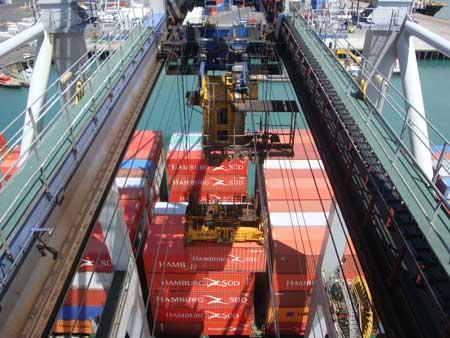Bridon’s products have achieved outstanding results on container cranes and straddle carriers operated by The Ports of Auckland. Stefan Richter learned that this success can be traced back to a tweaked construction and regular lubrication.
Auckland-based Bridon New Zealand Ltd have plenty of reasons to be in a festive mood. Exactly 100 years ago the William Cooke & Co (NZ) Ltd was established in Albert Street, and in 1961, 50 years later, the company’s rope making factory started production in New Zealand. But that is not all there is to celebrate. The company, which renamed Bridon in 1974, has just announced some remarkable results their wire ropes have achieved in conjunction with the Ports of Auckland. Here the wire ropes are mainly utilised in two applications: the Ports’ container cranes and straddle carriers. “In recent times we have seen the life expectancy double on the crane hoist ropes. And our straddle carrier ropes outperform the competition by considerable margins,” says Andy Palmer, Product Manager Wire Rope, Bridon NZ. “The Ports have just finished testing a competing product from Germany on their straddle carriers, and it lasted for only about 4000 hours. With approximately 7000 hours we are getting a significant longer life out of our wire ropes.”
“Predominantly we are talking hoisting wires here, though there are other applications on our ship to shore container cranes,” explains Derek Cowley, Inspector of Machinery, Ports of Auckland. “We require having a low maintenance, long life wire rope which we can rely on to provide a predictable and well above average service life.” Bridon’s record-breaking products are named Endurance Dyform 6 and 8PI, with the eight-stranded version featuring a plastic encapsulated core. Whereas the former wire rope is manufactured in Bridon’s factory in East Tamaki, the latter rope is imported from Bridon in the UK.
“The six-strand Dyform container crane wires have been developed specifically for our applications, using modern manufacturing methods and careful raw material selection,” reports Derek Cowley. “These wire ropes have been beating previous benchmarks for durability in service. And the eight-strand straddle carrier wires, though similar in specification to other products in the marketplace, have consistently provided an extended life and allowed us to retain these in service for what has been an unprecedented 7000 hour operational life.”
Recipes for successful wire rope
A wire rope consists of a multi-wired core strand that has a number of likewise multi-wired strands laid around it. The strands are produced in different combinations of wire materials and sizes to resist fatigue and abrasion and meet the specific needs of various applications. Understandably the company does not communicate the exact details on how to produce successful wire ropes that outlast competing products, but at least Andy Palmer gives a hint at how they managed to achieve their outstanding results. “At a meeting some time ago we discussed possibilities to improve the life expectancy of wire ropes, and Chris came up with the idea of slightly tweaking the construction, which means changing the recipe for our ropes. We did that and also started to subject the wire strands to a compaction process called dyforming or dyswaging,” recalls the Product Manager. This process modifies the shape of a wire and its dimensions without altering its metallic cross-sectional area, resulting in a denser wire, reduced friction within the strands and a stronger wire rope.
The “Chris” mentioned by Andy Palmer is Chris Loftin, Technical Manager Wire Rope. He reveals another modification that contributed to the increased life expectancy of Bridon’s wire ropes: “The more wires you put around a strand the bigger the centre wire becomes, and with it the diameter of the wire rope, resulting in decreased flexibility and increased strain. We have therefore increased the flexibility of the rope core dramatically, which helps us limit the overall diameter of the wire rope.” Chris Loftin also points out the importance of regularly lubricating the wire ropes – during its production as well as during its operational life. “The Ports of Auckland monitor their wire ropes frequently, they also keep extensive records and implement stringent inspection and lubrication programmes. This practise also contributes to the increased operational life of our products.”
“The inspection and lubrication programmes in place have certainly contributed to achieving these high hours recorded,” agrees Derek Cowley. “Regular though not excessive inspection has allowed us to track deterioration in service and predict in good time the end points of these wire ropes with confidence.” Most of these ropes have automatic wire lubrication systems and where not fitted and manual lubrication is required, the key is to ensure that lubrication takes place on a regular scheduled basis. “The experience gained through trial and error has assisted us in the choice of the various lubricants selected in the different applications.”






